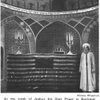Disclaimer
This entry contains information known to us from a variety of sources but may not include all the information currently available. Please be in touch if you notice any inadvertent mistakes in our presentation or have additional knowledge or sources to share. Thank you.
Archive
Tomb of the High Priest Joshua (Jeshua) at Baghdad, Iraq
A shrine whose holy occupant, as is so frequently the case with purported shrines, is shrouded in some mystery. The "Joshua" burried here is said to have been a Babylonian Jewish leader, although there is a tradition that claims him to have been "high priest Joshua (Zech. iii. 1)... and, according to Teixera and Benjamin the Second, the Jews are accustomed to make pilgrimages thither every month. The shrine is maintained by the contributions of the Jews in Bagdad and in India, and is used not only as a synagogue, but as a burying place for the rabbis."1 Another similarity to other locales: a dispute about ownership, as Jewish shrines are also frequently venerated by Muslims. The burial of Chief Rabbi, Hakham Abdalla Somekh, in the shrine's courtyard in 1889 led to the persecution of Baghdadi Jews by the city's gouverneur, who even imprisoned the new Chief Rabbi. The goveneur was removed after a "memorial on the subject was addressed to the marquis of Salisbury Oct. 25, 1889, on behalf of the Jewish Board of Deputies and the Anglo-Jewish Association."2 Decades later the shrine featured in the Nazi-inspired pogrom in Baghdad known as the Farhud. According to the Government Committee for Investigating the Events of 1-2 June 1941 (as summarized by Dr. Zvi Yahuda in Nahardea: Journal of the Babylonian Jewry Heritage Center, No. 15, Winter 2005/2006):
the riots broke out on the morning of Sunday, 1 June 1941 (the first day of the Pentecost [Shabu'ot] festival), next to the al-Khirr bridge situated in al-Karkh, the western part of Baghdad, on the main road to the tomb of Joshua the High Priest. Soldiers of the Iraqi army together with civilians fell on Jews making their way to visit the tomb, as was their custom in celebrating the Pentecost holy day. The writers of the report believed that this onslaught, which was not put down right at the start by the army and police authorities, was the direct cause of the riots at al-Rusafa, the district in Baghdad where concentrations of Jews were located. However, local Jewish sources, who agree with what the report contains as to details of the incident, in which soldiers and Muslim civilians injured the Jews, diverge from its contents regarding the background to its onset. These sources maintain that this was not the Jews' setting off to celebrate the Pentecost festival by visiting the tomb of Joshua the High Priest but their participation at a reception held for the Regent and his entourage on their return to Baghdad.3
Questions linger about the Jews who were first attacked, whether a delegation of Jewish notables who had been attending a reception with the Regent at the Palace of Flowers (Qasr al-Zuhur), or "a different group of Jews, defined as young people, who were on their way to the festivities at the tomb of Joshua the High Priest and crossed the bridge after the deputation of Jewish notables had returned."4 If, as the report maintains,
the attack on the Jews [took] place close to the palace where the Regent and his retinue resided and operated, and on the main road connecting the Palace of Flowers to the Baghdad international airport and the British Embassy... How did it happen that at a place so sensitive to the security of the British and the rulers who supported them, riots could erupt, and a bloody incident could occur in which Jews were injured and killed? Had the British neglected the security of the road connecting their Embassy with the residence of the Regent and allowed the assembly of armed soldiers and civilians who opposed them and their supporters among the domestic rulers?5
Unfortunately, "the report of the Committee and the British sources did not trouble to address these questions."6
Description
Sources
[1] Richard Gottheil and M. Franco, "Bagdad" in Jewish Encyclopedia, 1906. https://www.jewishencyclopedia.com/articles/2348-bagdad
[2] Ibid.
[3] Dr. Zvi Yehuda "The Outbreak of the Pogrom (Farhud) of June 1941 in aghdad," Nahardea: Journal of the Baylonian Jewry Heritage Center, No. 15, Winter 2005/2006. http://web.archive.org/web/20130930101604/http://babylonjewry.org.il/new/english/nehardea/15/4.htm
[4] Ibid.
[5] Ibid.
[6] Ibid.
Sources
Reference
See: Chapter 5 "Events Surrounding the Burial of Rabbi Adalla Somekh (1889) and Their Consequences" in Zvi Yehuda, The New Babylonin Diaspora: The Rise and Fall of the Jewish Community in Iraq, 16th-20th Centuries C.E. (Leiden: Brill, 2017)

